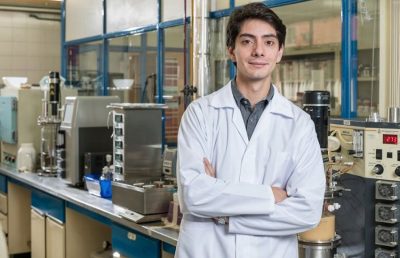How to set up a DIY Lab during lockdown, and what to do when it blows up: A case study from Xilinat

TFF Challenge Finalist team Xilinat from Mexico has developed a proprietary biotechnological fermentation process to transform agricultural waste into xylitol, a natural, low-calorie sugar substitute. Their product helps to fight diabetes and obesity, and addresses increasing consumer demands towards nutritious and healthy foods.
Due to the pandemic’s lockdown situation, Xilinat had to move their research closer to home. They set up a DIY Lab, and here Founder Javier Larragoiti shares some tips and tricks to support other science-based entrepreneurs during these challenging times:
Why did you decide to set up a DIY lab?
The first step of our process is a mashing method done with hot water and an acid catalyzer. This step is needed to release xylose from the agricultural wastes. We then ferment that xylose to xylitol.

We are currently working on an ultra scaled-down approach to optimize the operating variables of the process for two agricultural waste streams: agave bagasse from tequila production and corn cob. The idea is to minimize the environmental footprint and the economic costs of the process prior to jumping to a pilot plant.
As we are working on a small scale, we thought that it would be a great idea to build a couple of labs at home for our R&D team to continue working during lockdown. As we are lab-rats and nerds, it has resulted in an excellent experience! Imagine having the chance to wear a lab-coat around the house and continue doing interesting research for the company from the comfort of your home!
Is the lab crucial to continue executing your business?
Definitely! Our main goal is to scale-up our technology and demonstrate that it is totally feasible on an industrial scale. Therefore, optimizing all variables of the process is crucial for the next steps. Also, we have a partnership with the company that is providing the agave bagasse from their Tequila production, and we didn’t want to take too long for showing them promising results
Where did you get the equipment from?
We had to buy everything second-hand from local lab material providers. It was a huge challenge as most of them demanded papers that showed that we were actually using the equipment on a lab facility. In the end, we demonstrated that there are no major risks in the process and that all experiments could be safely done at home (and we were very certain of it).
What to consider when setting up a DIY lab—can you share some practical tips with us?
The advice varies depending on the type of DIY lab that you want to build. For example, it is easier (but probably more expensive) to establish a lab for optimizing a 3D-printing process in terms of safety, space and services.. In our case, we are optimizing a chemical method so we had to be certain that:
- The team is well trained in regards to lab safety.
- There was enough space far from people to work.
- The providers of equipment and materials were trustworthy (pay close attention to this point!).
- The team feels confident and okay with the idea of doing lab trials at home.
- The procedures are well known (in this case, all techniques have been generated in-house).
- Most importantly, there are no major risks in terms of the health and safety of the team.
Another thing to check before you launch into setting up your DIY lab is that it is economically feasible.
You sent us a photo of your lab exploding – what happened and what now?

It was a normal day, everything was working fine… and then two pieces of equipment exploded! We sent both pieces to the provider to investigate the incident. Fortunately, no one was harmed. It was less intense than a pressure cooker explosion.
The results of the investigation showed that the glass microreactor broke because the material the provider selected was not useful for pressures over 12 psi—although it was one of the characteristics we asked for. After the reactor broke, the liquid fell into the hot heating mantle, evaporated, and made the mantle explode internally, which finished up breaking some of the glassware.
The provider now sent a new stainless steel reactor and a new heating mantle and are now continuing with our experimental work and ensuring we follow our lab safety measures.
●●●
The TFF Community has access to incredible tools locally to accelerate their innovation efforts, no matter where in the world they are located. Things like: DIY kits to learn, build, and tinker outside the confines of schools, universities or expensive labs, and publicly available makerspaces equipped with production resources like 3D printers, laser cutters and digital modelling equipment to create prototypes and products quickly, easily and cheaply.
In addition, we are making resources available on the TFF Digital Labs, such as the access to the Wikifactory open-source community that provides resources for food hardware projects and connect people innovating in that space.
Most importantly, TFFers are driven by an ethos of collaboration and sharing—hopefully, their actions can inspire other entrepreneurs who face similar challenges, and, if you have experience building and running a DIY Lab, we invite you to share your experiences back with Javier and our Community here.
COVID COLLABORATION COLLECTIVE
More from the Covid Collaboration Collective
Our recently-launched Covid Collaboration Collective (Co3) collects and shares the solutions that TFFers around the world are developing, so that they can be deployed more quickly in other places.